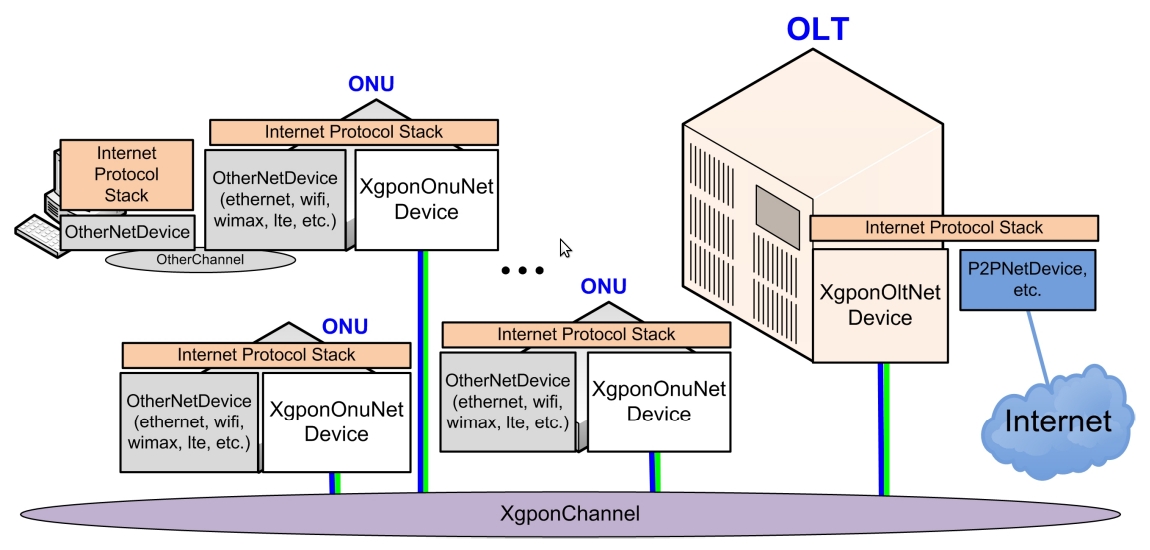Description
10-Gigabit-capable Passive Optical Network (XG-PON) [2], one of the latest standards of optical access networks, is regarded as one of the key technologies for future Internet access networks. However, to ensure that users can enjoy the abundant bandwidth provided by XG-PON, it is worthwhile to study the performance of XG-PON itself, the integration of optical and wireless networks, and the interactions between XG-PON and the Internet protocols. Thus, this XG-PON simulation module has been developed based on NS-3 [3], the state of the art network simulator.

<Fig.1>
The Reference XG-PON Simulation
Fig. 1 illustrates a typical way of simulating XG-PON with our module. The OLT is simulated as a node that has one XgponOltNetDevice and another network device, such as PointToPointNetDevice, to connect to an external network. The ONU is simulated as a node with one XgponOnuNetDevice and other network devices (Ethernet, WiFi, WiMAX, LTE, etc.) for connecting user equipments to the ONU. The OLT and ONUs are attached to XgponChannel that simulates the optical distribution network (ODN) of XG-PON. Through changing the parameters and algorithms exported by our XG-PON module, the performance of one XG-PON network can be studied. With the more realistic Internet protocol stack of NS-3, this module can be used to study the interaction between XG-PON and Internet protocols, i.e., improve the performance experienced by users in XG-PON networks. With the existing NS-3 modules for various wireless networks (WiFi, WiMAX, LTE, etc.), we can also study the integration between XG-PON and wireless networks, which is the trend of the future Internet access networks. Furthermore, not only XG-PON, this XG-PON module can also be extended to study Long-Reach PON (LR-PON), an evolution of XG-PON with a larger number of users (>=1000), symmetric data rate (10 Gb/s in both upstream and downstream), and longer reach (100+ km) [4][5]. The aim of our LR-PON research group in CTVR project is to initially build LR-PON from the XG-PON standard, while identifying the required modifications and improvements.
This XG-PON module is designed and implemented with aim to provide a standards-compliant, configurable, and extensible module that can simulate XG-PON with reasonable speed and can support a wide range of research topics. The initial design of this module has been published in the NS-3 Workshop 2013 [1] and signifant development&refactoring have been carried out since then. This module is now built completely in C++ with 72 classes and approximately 22,000 lines of code. Evaluations on a COTS server (2.80GHz, one core is used in simulation) indicate that our XG-PON module takes around 160s to simulate one second even when there are 1000 ONUs and the downstream network load is 9.6Gbps with which XG-PON has been over-loaded. More details are available in the manual (pdf).
This work is supported in part by Science Foundation of Ireland through CTVR.
Source code is under the GNU General Public License and is available here.
Please cite [1] if this module is used in your work.
Reference
- [1] Xiuchao Wu, Kenneth N. Brown, Cormac J. Sreenan, Pedro Alvarez, Marco Ruffini, Nicola Marchetti, David Payne, and Linda Doyle, An XG-PON Module for the NS-3 Network Simulator, Workshop on NS-3, 2013
- [2] 10-Gigabit-Capable Passive Optical Networks (GPON) Series of Recommendations, G.987.x, ITU Std., March 2010. (http://www.itu.int/rec/T-REC-G/e)
- [3] The NS-3 network simulator (http://www.nsnam.org/), 2008.
- [4] D. Payne and R. Davey, The future of fibre access systems?, BT Technology Journal, vol. 20, no. 4, October 2002.
- [5] D. Shea and J. Mitchell, A 10-gb/s 1024-way-split 100-km long-reach optical-access network, Journal of Lightwave Technology, vol. 25, no. 3, March 2007.
Last updated on 16, Jan., 2014 by Xiuchao Wu (xw2@cs.ucc.ie)